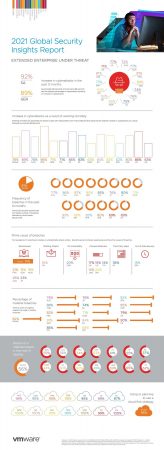
VMware releases report detailing surge in cyberattacks
by CM Staff
Report highlights opportunity for Security Leaders to rethink and transform cybersecurity strategies

VMware Global Security Insights Infographic (CNW Group/VMware)
TORONTO — VMware, Inc. released the findings from the fourth installment of the Global Security Insights Report. The Canada report is based on an online survey of 251 Canadian CIOs, CTOs and CISOs in December 2020. The report explores the impact of cyberattacks and breaches on organizations and details how security teams are adapting to these challenges.
Accelerated digital transformation has caused security teams to face evolving threats as cybercriminals seize the opportunity to execute targeted attacks exploiting fast-tracked innovation and the anywhere workforce. Close to 86 percent of organizations surveyed experienced cyberattacks due to more employees working from home, highlighting the vulnerabilities in legacy security technology and postures.
“We’ve seen a substantial uptick of digital transformation across Canada over the past year, and cloud technology adoption has presented an incredible opportunity for business leaders to rethink their approach to cybersecurity in the new normal,” said Sean Forkan, Vice President Security Sales – Americas, VMware. in a prepared statement. “As organizations look to better secure data and applications while protecting their endpoints and remote workers, they’re finding that legacy systems are no longer sufficient. It is imperative that Canadian organizations have the right tools and technologies in place to implement a security strategy built for a cloud-first world.”
The Canada Security Insights Report provides intelligence on the cybersecurity landscape, attack and defense trends, along with the security priorities for organizations this year to maintain resilience. The key findings include:
- A lack of urgency despite surge in material breaches. 86% of respondents have suffered a breach in the last twelve months with 8 out of 10 breaches (88%) considered material. Yet, security professionals have underestimated the likelihood of a material breach. Only 56% say they fear a material breach in the next year, and just one-third (31.5%) have updated their security policy and approach to mitigate the risk.
- Resurgence of ransomware and remote work creates unpredictable attack surface. 78% of respondents said attack volumes had increased – with majority pointing to employees working from home as the cause – and 79% said attacks had become more sophisticated. OS vulnerabilities was the most common cause of breaches, followed closely by third party apps (16%).
- Cloud-first security strategies are now universal. 95% of respondents already use or plan to use a cloud-first security strategy. But the move to cloud has expanded the threat surface. More than half (58%) agree they need to view security differently now that the attack surface has expanded. But only 34% of respondents plan to build more security into their infrastructure and apps and reduce the number of point solutions.
- Applications and workloads are top CISO concerns. Applications and workloads are viewed as the most vulnerable points on the data journey. 58% of respondents agreed they need better visibility over data and apps in order to pre-empt attacks. 63% of respondents said that their senior leadership team feel increasingly worried about bringing new apps to market.
- Security concerns are holding back adoption of AI. The next frontier for business innovation may be artificial intelligence, but more than half of respondents (64.5%) say that security concerns are holding them back from embracing AI/ML-based apps.
The pandemic and shift to anywhere work have undoubtedly changed the threat landscape requiring security teams to transform their cybersecurity strategies and stay one step ahead of attackers. Key focus areas for the coming year must include improving visibility into all endpoints and workloads, responding to the resurgence of ransomware, delivering security as a distributed service, and adopting an intrinsic approach to cloud-first security.